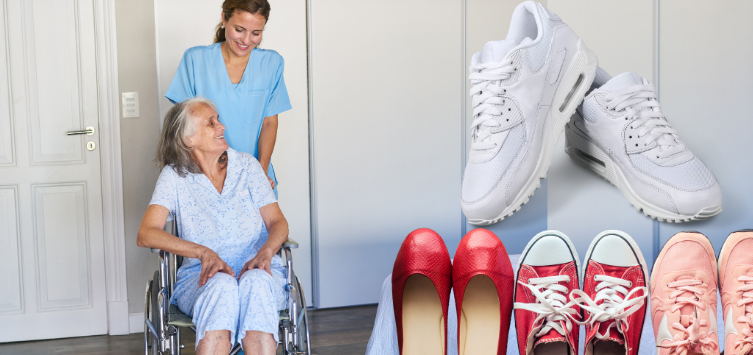


By Nancy Morgan, RN, BSN, MBA, WOCN
Each month Nancy Morgan Wound Care brings you a tool you can apply in your daily practice
Support Resources:
Infographics: Foot Care Diabetic Wound Characteristics
Description
Inappropriate footwear is the most common source of trauma in patients with diabetes. Frequent and proper assessment of appropriate footwear is essential for protecting the diabetic foot from ulceration.
In general, there should be about a thumbnail (approximately ½ to ¾ inch) distance between the end of your longest toe and the tip of the shoe.
Patients with a partial foot require a sock that will conform to the shape without distal prominent seams or excess material at the distal end.
For active patients, socks can be obtained with silicone over high-stress areas to prevent shear for full or partial feet.
When purchasing new footwear, encourage patients to wear heaviest socks while trying on different types of footwear.
Note: A number of studies have shown that wearing athletic shoes can reduce plantar pressure and lead to fewer calluses.
The simplest intervention for a patient who is at risk for ulceration would be a good-fitting, well-cushioned pair of athletic shoes if the patient’s foot fits well in the upper area.
Patient education about the importance of appropriate footwear choices is critical for the prevention of diabetic foot ulceration and possible amputation. In addition to the points already discussed, patients should be advised to:
Selected References
Bar, Ron. (2019, Sept. 9). What is special about diabetic shoes? OrthoFeet. https://www.orthofeet.com/blogs/news/what-is-special-about-diabetic-shoes
Cavanagh, PR; Ulbrecht, JS. (2008). The biomechanics of the foot in diabetes mellitus. In Levin ME, O’Neil LW, Bowker JH, et al, eds. The Diabetic Foot. 7th ed. Philadelphia: Mosby Elsevier.
Nancy Morgan RN, BSN, MBA, WOC is an experienced clinician, successful business leader, and accomplished nurse educator in the field of wound management. She is the co-founder of the Wound Care Education Institute, (WCEI®), Wild on Wounds Productions; and, most recently established Nancy Morgan Wound Care offering innovative, educational resources including seminars, webinars, social media and wound care marketing tools to assist and support wound care clinicians at the bedside. Nancy is one of the most distinguished wound care educators, delivering nearly 1200 lectures, conference keynote addresses, seminars, webinars, and bedside consultations during her career.
Information is courtesy of Nancy Morgan Wound Care, copyright 2021.
DISCLAIMER: All clinical information and recommendations, text and graphics, in this blog are intended to assist with determining appropriate wound therapy for patients. It is not intended to be a substitute nor constitute providing medical care or advice, diagnosis, or treatment. Responsibility for final decisions and actions related to care of specific patients shall remain the obligation of the institution, its staff, and the patients’ attending physicians. Individuals should always contact their healthcare providers for medical or emergency-related care.